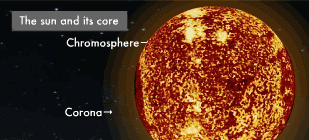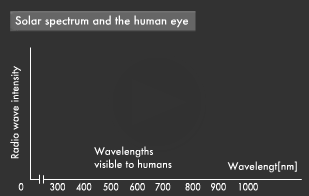Canon Science Lab
Sunlight
When you hear the word "light," what comes to mind? For most people, the answer is sunlight. The sun constantly emits light.
Light continuously reaches the earth from the sun. You might also say, "The sun sends electromagnetic energy as light."
The electromagnetic waves emitted by the sun are of a broad spectrum ranging from X-rays with a wavelength of 2 nanometers to radio waves with a wavelength of 10 meters. The most intense of these to reach the earth's surface is visible light, with a wavelength around 500 nanometers.
The energy the earth receives from the sun is called the "solar constant," which is defined as 2 calories per square centimeter per minute. Based on meters squared, the solar constant is equivalent to 1.4 kilowatts, or one electric heater. The energy reaching the earth's surface is less than this value, owing to such factors as atmospheric absorption, but the sun is nevertheless a major source of energy for the earth.
The Sun Was Born 5 Billion Years Ago
The sun is a star with a 696,000-km radius. Its volume is so great it could fit 1.3 million earths inside it, and it is 330,000 times as heavy as our planet. Although our sun is so much larger than the earth, it is only of average size among the other stars in our galaxy. Its surface and core temperatures are 6,000 degrees Kelvin and 15,000,000 degrees Kelvin, respectively.

How do you suppose our sun was born? It is said the sun was born some 5 billion years ago. At that time, a giant star in our galaxy ended its life in a cataclysmic supernova explosion. The shockwaves from such an explosion would compress the surrounding gases that, as they cooled, formed a cloud containing a mixture of dust and hydrogen atoms and molecules. This cloud contracts over a long period of time under their own gravity, causing them to grow denser and heat up internally. Once their core reaches a sufficient temperature (about 10,000,000 degrees Kelvin), nuclear fusion begins, meaning that hydrogen atoms start fusing together to form helium. With the start of nuclear fusion, stars begin emitting massive amounts of energy, making them shine. This is how the sun was born, and is also the reason why stars like the sun, which emit their own light, are immense masses of gas in which nuclear fusion is occurring at the core.
The Nuclear Fusion Energy of Our Sun Is Immense
It is thought that the nuclear fusion occurring in the sun's core fuses 650 million tons of hydrogen every second, transforming it into helium. The energy generated during nuclear fusion becomes heat, and this heat energy from the core is constantly transmitted to the sun's surface, while keeping the core at high temperature.
The amount of energy the earth receives from the sun is equivalent to as many as 200 million 1-million-kilowatt power plants.

Still, since that accounts for only 1/2 billionth of the total energy emitted by the sun, you can easily understand the enormity of its nuclear fusion.
The heat energy transmitted to the sun's surface forms vortices of gas there. The convection of these vortices sometimes results in powerful magnetic fields. Whenever there is a concentration of magnetic fields on the sun's surface, explosive events known as sunspots and solar flares occur.
Yellow Light Is the Most Intense Wavelength in Sunlight
What color do you see in the light reaching us from the sun? Separating sunlight into its component wavelengths results in the spectrum shown below. The greatest amount of sunlight is emitted at wavelengths around 500 nanometers, so you can easily see why sunlight appears yellow. This spectrum matches the spectrum of light emitted by an object at 6,000 degrees Kelvin in temperature, which backs up the previously mentioned fact that the surface temperature of the sun is 6,000 degrees Kelvin.

As you can see, the spectrum of electromagnetic waves emitted by a heated object can be used to figure out its temperature. For example, Sirius, a bluish-white first magnitude star in the constellation Canis Major, is known to have a high surface temperature exceeding 10,000 degrees Kelvin.
The Human Eye Evolved by Adapting to the Sun
You have undoubtedly noticed that the sun appears yellow rather than bright red. The kind of light detectable by the human eye is called visible light, which has a wavelength between around 400 to 700 nanometers. The human eye is said to be most sensitive to light in wavelengths around 500 nanometers. It is believed that the reason behind this sensitivity is the evolution of the human eye by adaptation to the solar spectrum.

If the sun were a much hotter star, the range of visible light would have been different. However, the environment on present-day earth would likely be far different, and it is doubtful that human beings and other organisms would ever come into being.
